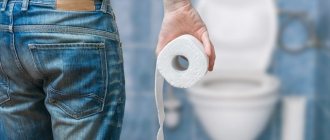Every Monday on AiF Health - a new set of exercises for beauty and health. This week - a set of 8 exercises that will help improve intestinal function, strengthen the abdominal muscles and improve blood circulation in the abdominal organs.
The remains of digested food lingering in the intestines poison the body with toxins, cause headaches, insomnia, anxiety, and can cause more serious health problems. A single case of constipation is not so terrible, but if it becomes chronic, immediate action must be taken.
Preparing for a massage for a child
Before performing a abdominal massage, it is necessary to create all the conditions for its implementation so that the undressed baby does not freeze and feels comfortable.
- There should be no drafts in the room.
- The optimal indoor air temperature is 23 °C.
- Abdominal massage for constipation should be carried out on a hard surface, for example on a changing table or sofa, where you should first lay a blanket or terry towel, and an oilcloth on top.
- Tummy massage should be done using emollients (baby oil or milk), which make it easier for your hands to glide over the baby's skin.
- Before the procedure, you need to wash your hands and, if necessary, warm them in hot water. The child will not like the touch of cold fingers, and the session will not be beneficial.
Up to contents
Symptoms of constipation
The following conditions can be considered constipation:
- rare bowel movements compared to the individual norm;
- difficulty in defecation, the need for strong straining, even if the frequency of stool remains within the individual norm;
- incomplete bowel movement, which occurs in at least a quarter of cases of bowel movements.
Acute and chronic constipation are also distinguished. Acute constipation is an episodic situation that lasts a short time. The cause may be the consumption of strengthening foods, certain medications, stress, and more.
Chronic constipation is defined as constipation in which the above symptoms are present for 3 months or more. In this case, it is first necessary to exclude diseases that can lead to its development, and only then draw up a treatment plan.
How to massage babies under 3 years old
Healthy physical activity is an excellent preventative against constipation. But while the child is small, he should regularly massage his tummy and do exercises with a special set of exercises. The purpose of such exercises is to improve intestinal motility.
Massage for constipation is very simple. Soft circular strokes clockwise around the navel, as well as movements directed from the sides to the navel, are sufficient. This massage should be done daily (up to 4 approaches), repeating each movement up to 10 times.
As soon as the baby grows a little (2–3 years), he needs to be provided with maximum physical activity. Its daily exercise should include a set of special exercises that will help improve intestinal function.
- To strengthen the abdominal muscles, you need the baby to pull his tummy in deeply and then slowly release it. You need to repeat the exercise 2 sets of 10 times.
- To strengthen your pelvic floor muscles, you can perform the following exercise. The child should be placed on his back or placed in a high chair. Then raise his leg as high as possible and fix this position for a few seconds, the second leg should hang freely. Returning to the starting position, repeat the exercise with the second leg. During charging, it is advisable to perform this movement 5–10 times for each limb.
- To improve the movement of feces through the intestines and speed up their removal from the body, you can do very light pushes with the tummy. To do this, ask the child to inhale and draw in his stomach, then exhale and push it out. This should be done at least 10 times in the morning and evening.
If your baby doesn’t like such exercises, you can go swimming, it also helps get rid of constipation.
Up to contents
Gymnastics
To prevent the pathological condition, walking and running, swimming, exercises to strengthen the abdominal press, squats, and bends are useful.
It is believed that mobile, active children suffer less from constipation. To prevent the pathological condition, walking and running, swimming, exercises to strengthen the abdominal press, squats, and bends are useful.
If your child is already suffering from bowel problems, it is recommended to start the day with simple morning exercises. Massage may also be helpful.
It is important to pay attention to the general change in the baby’s behavior.
The child should be taught to go to the toilet at approximately the same time and encouraged for following the daily routine (motivated and praised).
It is also important to create a favorable environment in the toilet. Nothing should distract the child from the act of defecation or frighten him in the bathroom.
Exercises for constipation for children over three years old
Exercises for constipation are a special set of fairly effective exercises aimed at improving intestinal motility. This kind of gymnastics is best done in the form of a game, then the baby will be happy to do all the necessary movements. Parents must necessarily participate and help the child, showing everything by example.
- Flexion-extension of the torso.
The baby needs to place his feet shoulder-width apart and place his hands on his waist. Next, you should bend forward, trying to bend over as much as possible, and then return to the starting position. Repeat at least 15 times. - "Bike"
. The baby needs to lie down on a hard surface, raise his legs and perform circular movements, imitating riding a bicycle. It is enough to do 10–15 movements for each leg. - Bend the torso to the side.
Take the starting position: feet shoulder-width apart, arms spread to the sides. Bend left and right so that your arms are parallel to your body, and then return to the starting position. Repeat the bends 10 times on each side. - Torso rotations.
Feet should be shoulder-width apart, hands on your waist. You should alternately turn your body left and right. Perform 10 times in each direction. - Raising your legs.
The child should lie on his back and straighten his legs. Without bending your knees, try to raise them perpendicular to the floor. Repeat the exercise 10 times.
Up to contents
Diet
What can you give your child for constipation?
This question interests many parents. The fight against the problem should begin not with taking medications, but with changing your diet.
Necessary:
- Increase fluid intake
- Set up fractional meals
- Add fiber-rich foods to your diet
You should teach your child to drink plain, clean water. Typically, for children over 3 years of age, 2-3 glasses of water per day are sufficient. Sugary carbonated drinks, coffee and tea should be avoided. This is due to the fact that they have a pronounced diuretic effect and stimulate constipation and dehydration.
Cool water, which children drink in the morning on an empty stomach, is especially beneficial. Gradually, the temperature of the liquid can be reduced. The following drinks also have a laxative effect:
- beet juice
- fermented milk (kefir, fermented baked milk, etc.)
- chamomile decoctions
- tea with dill
Important! They should be introduced into the diet gradually, starting with small amounts. Otherwise, you can provoke digestive breakdown.
You should teach your child to drink plain, clean water. Typically, for children over 3 years of age, 2-3 glasses of water per day are sufficient.
Treatment of constipation in children also involves the introduction of foods with a laxative effect into the diet, which include:
- legumes
- nuts
- prunes and dried apricots
- plum
- beets
- dates
They are also included in the diet gradually and under the supervision of a doctor. Cereal porridges may be useful: oatmeal, buckwheat, wheat, pearl barley. It is advisable to avoid rice, pears, sweets, baked goods, animal fats, and flour products. They have a fixing effect.
What else should I feed my baby to avoid constipation?
The answer to this question should be given by a pediatrician.
The benefits of exercise therapy
Exercise for constipation is a safe remedy that is suitable for people of all ages. After their regular use, people note the following improvements:
- General health promotion;
- Reducing psycho-emotional tension;
- Improved mood;
- Strengthening the nervous system;
- Restoring proper bowel function.
Note!
Long-term use of laxatives worsens intestinal function by reducing intestinal motility.
With the help of gymnastics for constipation, the intestines are “massaged”, which stimulates the following processes:
- Improved towing capacity. With its help, food “passes” to the exit faster.
- Correction of peristalsis. Food remains do not settle on the intestinal walls.
Additional benefits of gymnastics for constipation include the following factors:
- Safety – well-chosen exercises will not harm anyone;
- Accessibility – you can train at home, in the park or on a picnic in the forest;
- Variability - people of all age groups and health conditions can choose the right complex.
However, good results from therapeutic exercises can only be achieved with regular exercise. By performing each exercise 15-20 times daily, you will get rid of constipation forever.
Contraindications
It is better to avoid training if you feel unwell. You should not use gymnastics without consulting a doctor in the following conditions:
- Pregnancy;
- Menstruation;
- Ulcer during exacerbation;
- Umbilical hernia;
- Hypertension;
- Internal bleeding.
Properly selected and correctly performed physical exercises will not harm anyone. And for them to bring maximum benefit, it is better to combine training with proper nutrition and other physical activities: dancing, yoga and swimming.
What do experts advise?
If for some reason you can’t do gymnastics in the morning, you can do the exercises during the day, but you just need to make sure that at least 2 hours have passed from the moment of your last meal to the actual gymnastics class. You can not limit yourself to the set of exercises proposed below and additionally perform others that you can do and will not cause overwork or complications of cardiovascular diseases and musculoskeletal problems.
Since one of the most common causes of constipation is physical inactivity, increasing physical activity and mobility will definitely be beneficial. The main thing is that you don’t need to be overzealous and do heavy strength exercises or immediately start with high loads. Everything should be done gradually and to the best of your physical abilities.
Recommendations for charging
In order to choose the right set of exercises, you need to see a doctor and undergo an examination prescribed by a specialist. It is important to establish the true cause of the pathology, determine its type and take into account contraindications.
Only in this case can you be sure that charging will bring benefits and not cause harm.
Indications
The main indication for gymnastics is constipation. However, there are many types of chargers. How to choose the right complex? Initially, the type of pathology should be determined.
There are 2 types of constipation:
- Atonic. Regular defecation is not observed due to weakening of the intestinal muscles. With this pathology, peristalsis is reduced and the movement of contents is difficult. Sometimes doctors call this phenomenon “lazy” bowel syndrome. A similar problem can develop after strip operations, with a low level of mobility, and pathologies of the gastrointestinal tract (gastrointestinal tract). Atonic constipation is characterized by copious stools of dense consistency. Against the background of such an act of defecation, anal fissures and hemorrhoids often develop.
- Spastic. Intestinal motility is completely preserved. However, a person experiences severe spasms that disrupt the movement of the food bolus. Atonic constipation is characterized by “sheep-like” hard stools, bloating, and a feeling of incomplete evacuation. The process of defecation causes the patient to strain greatly and is accompanied by pain.
Spastic constipation is manifested by cramps and pain in the intestines
The main goal of gymnastics is to normalize peristalsis and eliminate congestion in the intestines.
But depending on the type of constipation, the recommendations will be slightly different:
- With atonic appearance. Charging must be done at an average (closer to fast) pace. The exercises are repeated many times. For such constipation, the following are very useful:
- springy movements that improve peristalsis;
- strength exercises that involve resistance or weights;
- gymnastics that strengthens the abdominal muscles;
- jumping, squats, running.
- With spastic In this case, gymnastics should provide relief from spasm. Classes are held at a slow pace. It is recommended to limit abdominal exercises. The following types are great:
- gymnastics to relax muscles;
- Exercise therapy for osteochondrosis of the lumbar zone;
- swimming.
Squats are useful for atonic constipation
Possible contraindications
There are some restrictions. Intestinal exercise is contraindicated if:
- pregnancy;
- fever;
- umbilical hernia;
- internal bleeding;
- peptic ulcer of the digestive tract;
- hypertension.
Gymnastics for the intestines has virtually no side effects, provided that the patient performs it according to the doctor’s recommendations. In addition, unlike laxatives and enemas, it is completely harmless to the body.
But it is still necessary to adhere to some rules to ensure the most effective and quick elimination of an unpleasant problem.
Gymnastics is contraindicated for people suffering from hypertension
Warm mineral water
Some mineral waters containing sulfates enhance the motor function of the intestines throughout its entire length. If there are no contraindications from the stomach or other organs (it is better to consult a doctor about this), you can drink this water on an empty stomach in the morning. Take 0.5 liters of mineral water, having first opened and released the gas from it. Heat gently to a pleasant, non-burning temperature and drink in small sips with a teaspoon of honey. Then lie down for a while, or at least spend half an hour in a calm environment. The result will not be long in coming.
Eliminate constipation
Eliminating the problem of constipation should be carried out using comprehensive measures. This includes increasing physical activity, adjusting your diet, and drinking enough fluids. Correction of drug therapy that the patient takes for other diseases, etc.
Breathing exercises also have a good effect. It helps keep the abdominal muscles toned and stimulates intestinal peristalsis. We offer the following set of exercises, which can be performed independently at home and even with bedridden patients who are accessible to contact.
Vegetarian food
Any plant food contains fiber in excess, which cleanses the intestines. Therefore, vegetarians do not even know what constipation is. Meat and meat products, as well as animal fats contained in milk, cheese, sour cream, butter, contribute to the concentration of waste and the high content of bile acids in them, which not only provokes constipation, but also makes them dangerous for the intestinal mucosa. Pectins have the exact opposite effect, which are delicate fibers that are beneficial for the mucous membrane, cleansing it like a soft sponge. There are a lot of them in baked apples, pumpkins, and zucchini. Try eating for a while with an excess of plant fiber in your diet, and you will forget about intestinal problems. Vinaigrette with vegetable oil, salads made from raw cabbage, carrots and apples, and greens are very useful.








